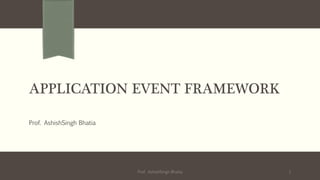Servlet Event framework
- 1. APPLICATION EVENT FRAMEWORK Prof. AshishSingh Bhatia 1Prof. AshishSingh Bhatia
- 2. What and Why ? ? Life cycle methods ? How to respond to major events in the life cycle of the web application ? ? Who will do what ? ? Eight kind of listeners that respond to web life cycle events. Prof. AshishSingh Bhatia 2
- 3. Listeners Interface ? ServletContextListener ? ServletContext AttributeListener ? HttpSessionListener ? HttpSessionAttributeListener ? HttpSessionActivationListener ? HttpSessionBindingListener ? ServletRequest Listener [ 2.4 ] ? ServletRequestAttributeListener [ 2.4 ] Prof. AshishSingh Bhatia 3
- 4. How ? ? Implement the appropriate interface. ? Implement the methods needed to respond to the events of interest. ? Obtain access to the important Web application objects. ? Use these objects. ? Declare the listener. ? Provide any needed initialization parameters. Prof. AshishSingh Bhatia 4
- 5. Take a Case Study and Think out of Box ? We are enterprise level [ Huge Company with lot many pages of web application ] ? Where company whose name changes frequently ? We need to display company name in all pages [ Servlet / JSP ] ? How we can do that ? Prof. AshishSingh Bhatia 5
- 6. Take a Case Study and Think out of Box ? As it is needed in application wide we will put it in web.xml as context-param <context-param> <param-name>companyName</param-name> <param-value>test.com</param-value> </context-param> ? In Servlet we will read it using String name = getServletContext().getInitParameter(Ą°companyNameĄą); Prof. AshishSingh Bhatia 6 Guess we have 100 [ Servlet / JSP ] If we forgot to add entry in web.xml ? Every Servlet / Page will display null !!!!
- 7. Monitoring creation and destruction of Servlet Context Prof. AshishSingh Bhatia 7
- 9. JSP File Prof. AshishSingh Bhatia 9
- 10. Take a new case Prof. AshishSingh Bhatia 10 What if servlet change the companyName of context-param ? Example : asbspace.in
- 11. Take a new case Prof. AshishSingh Bhatia 11 We should ensure that when company name is changed formerCompanyName should also be changed companyName = asbspace.in formerCompanyName=test.com ServletContextAttributeListener
- 12. HTML Form Prof. AshishSingh Bhatia 12
- 13. Servlet Changing Name Prof. AshishSingh Bhatia 13
- 15. JSP displaying new and old name of the company Prof. AshishSingh Bhatia 15
- 16. Session Related Listener ? For all Sessions ? ServletContextListener ? ServletContextAttributeListener ? For Specific Sessions ? HttpSessionListener ? HttpSessionAttributeListener ? Counting number of sessions ? HttpSessionListener Interface : sessionCreated and sessionDestroyed Prof. AshishSingh Bhatia 16
- 17. Prof. AshishSingh Bhatia 17
- 18. Prof. AshishSingh Bhatia 18 test.jsp makesession.html
- 20. Prof. AshishSingh Bhatia 20 Cookies must be disabled. So each jsp load will act as a request and create a new session
- 21. sessioncount.jsp output Prof. AshishSingh Bhatia 21
- 22. Watching for changes in Session Attribute ? HttpSessionAttributeListener interface. Implement attributeAdded, attributeReplaced, and attributeRemoved ? It gets notified when an object is placed into the session scope for the first time, replaced by another object, or removed from the session scope altogether. Prof. AshishSingh Bhatia 22
- 23. Task ĻC Self Study ? Suppose you want to track buying patterns for a specific item (a yacht, in this case). Of course, you could try to find all servlets and JSP pages that process orders and change each one to record yacht purchases. ThatĄŊs an awful lot of work for what sounds like a simple request, though, and pretty hard to maintain, anyhow. A much better option is to create a session attribute listener that monitors the attributes corresponding to order reservations or purchases and that records the information in the log file for later perusal by the sales manager. Prof. AshishSingh Bhatia 23
- 24. Calculating Server Request Load Prof. AshishSingh Bhatia 24
- 25. END OF SESSION 25Prof. AshishSingh Bhatia



![Listeners Interface
? ServletContextListener
? ServletContext AttributeListener
? HttpSessionListener
? HttpSessionAttributeListener
? HttpSessionActivationListener
? HttpSessionBindingListener
? ServletRequest Listener [ 2.4 ]
? ServletRequestAttributeListener [ 2.4 ]
Prof. AshishSingh Bhatia 3](https://image.slidesharecdn.com/eventframework-130430120651-phpapp02/85/Servlet-Event-framework-3-320.jpg)

![Take a Case Study and Think out of Box
? We are enterprise level [ Huge Company with lot many pages of web
application ]
? Where company whose name changes frequently
? We need to display company name in all pages [ Servlet / JSP ]
? How we can do that ?
Prof. AshishSingh Bhatia 5](https://image.slidesharecdn.com/eventframework-130430120651-phpapp02/85/Servlet-Event-framework-5-320.jpg)
![Take a Case Study and Think out of Box
? As it is needed in application wide we will put it in web.xml as context-param
<context-param>
<param-name>companyName</param-name>
<param-value>test.com</param-value>
</context-param>
? In Servlet we will read it using
String name = getServletContext().getInitParameter(Ą°companyNameĄą);
Prof. AshishSingh Bhatia 6
Guess we have 100 [ Servlet / JSP ]
If we forgot to add entry in web.xml ?
Every Servlet / Page will display null
!!!!](https://image.slidesharecdn.com/eventframework-130430120651-phpapp02/85/Servlet-Event-framework-6-320.jpg)


















